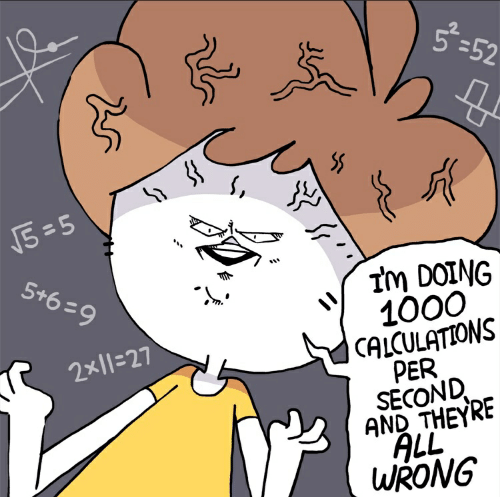For OpenAI, o1 represents a step toward its broader goal of human-like artificial intelligence. More practically, it does a better job at writing code and solving multistep problems than previous models. But it’s also more expensive and slower to use than GPT-4o. OpenAI is calling this release of o1 a “preview” to emphasize how nascent it is.
The training behind o1 is fundamentally different from its predecessors, OpenAI’s research lead, Jerry Tworek, tells me, though the company is being vague about the exact details. He says o1 “has been trained using a completely new optimization algorithm and a new training dataset specifically tailored for it.”
OpenAI taught previous GPT models to mimic patterns from its training data. With o1, it trained the model to solve problems on its own using a technique known as reinforcement learning, which teaches the system through rewards and penalties. It then uses a “chain of thought” to process queries, similarly to how humans process problems by going through them step-by-step.
At the same time, o1 is not as capable as GPT-4o in a lot of areas. It doesn’t do as well on factual knowledge about the world. It also doesn’t have the ability to browse the web or process files and images. Still, the company believes it represents a brand-new class of capabilities. It was named o1 to indicate “resetting the counter back to 1.”
I think this is the most important part (emphasis mine):
As a result of this new training methodology, OpenAI says the model should be more accurate. “We have noticed that this model hallucinates less,” Tworek says. But the problem still persists. “We can’t say we solved hallucinations.”
So for those not familar with machine learning, which was the practical business use case for “AI” before LLMs took the world by storm, that is what they are describing as reinforcement learning. Both are valid terms for it.
It’s how you can make an AI that plays Mario Kart. You establish goals that grant points, stuff to avoid that loses points, and what actions it can take each “step”. Then you give it the first frame of a Mario Kart race, have it try literally every input it can put in that frame, then evaluate the change in points that results. You branch out from that collection of “frame 2s” and do the same thing again and again, checking more and more possible future states.
At some point you use certain rules to eliminate certain branches on this tree of potential future states, like discarding branches where it’s driving backwards. That way you can start opptimizing towards the options at any given time that get the most points im the end. Keep the amount of options being evaluated to an amount you can push through your hardware.
Eventually you try enough things enough times that you can pretty consistently use the data you gathered to make the best choice on any given frame.
The jank comes from how the points are configured. Like AI for a delivery robot could prioritize jumping off balconies if it prioritizes speed over self preservation.
Some of these pitfalls are easy to create rules around for training. Others are far more subtle and difficult to work around.
Some people in the video game TAS community (custom building a frame by frame list of the inputs needed to beat a game as fast as possible, human limits be damned) are already using this in limited capacities to automate testing approaches to particularly challenging sections of gameplay.
So it ends up coming down to complexity. Making an AI to play Pacman is relatively simple. There are only 4 options every step, the direction the joystick is held. So you have 4n states to keep track of, where n is the number of steps forward you want to look.
Trying to do that with language, and arguing that you can get reliable results with any kind of consistency, is blowing smoke. They can’t even clearly state what outcomes they are optimizing for with their “reward” function. God only knows what edge cases they’ve overlooked.
My complete out of my ass guess is that they did some analysis on response to previous gpt output, tried to distinguish between positive and negative responses (or at least distinguish against responses indicating that it was incorrect). They then used that as some sort of positive/negative points heuristic.
People have been speculating for a while that you could do that, crank up the “randomness”, have it generate multiple responses behind the scenes and then pit those “pre-responses” against each other and use that criteria to choose the best option of the “pre-responses”. They could even A/B test the responses over multiple users, and use the user responses as further “positive/negative points” reinforcement to feed back into it in a giant loop.
Again, completely pulled from my ass. Take with a boulder of salt.
Again, completely pulled from my ass. Take with a boulder of salt.
You’re under arrest. That’s ass-salt.
Fuck you, that made me smile. And I haven’t even had my coffee yet.
Sorry for hitting you at a vulnerable time.
So they slapped some reinforcement learning on top of their LLM and are claiming that gives it “reasoning capabilities”? Or am I missing something?
It’s like 3 lms on top of eachother in a trenchcoat, and appau a calculator so it gets math right
“We have noticed that this model hallucinates less,” Tworek says. But the problem still persists. “We can’t say we solved hallucinations.”
On one hand, yeah, AI hallucinations.
On the other hand, have you met people?
Dang, OpenAI just pulled an Apple. Do something other people have already done with the same results (but importantly before they made a big fuss about it), claim it’s their innovation, give it a bloated name so people imagine it’s more than it is and produce a graph comparing themselves to themselves, hoping nobody will look at the competition.
Just like Apple, they have their own selling point, but instead they seem to prefer making up stuff while forgetting why people use em.
On a side note they also pulled an Elon. Where’s my AI companion that can comment on video in realtime and sing to me??? Ya had it “working” “live” a couple months ago, WHERE IS IT?!?
Meanwhile a bald turtle and his AI anime daughter on twitch can do exactly this, and he’s building her at home on nvidia GPUs.
(Vedal987 and Neuro-sama, if you’re curious)
That’s not what reasoning is. Training is understanding what they’re talking about and being able to draw logical conclusions based on what they’ve learned. It’s being able to say, I didn’t know but wait a second and I’ll look it up," and then summing that info up in original language.
All Open AI did was make it less stupid and slap a new coat of paint on it, hoping nobody asks too many questions.
trained to answer more complex questions, faster than a human can.
I can answer math questions really really fast. Not correct though, but like REALLY fast!

😋
It scores 83% on a qualifying exam for the international mathematics olympiad compared to the previous model’s 13% so…
I’m the same with any programming question as long as the answer is Hello World
That’s a flat out lie, I use it for code all the time and it’s fantastic at writing useful functions if you tell it what you want. It’s also fantastic if you ask it to explain code or options for problem solving.
It’s a better prediction model. There’s no reasoning because it’s not understanding anything you’re typing. We’re not closer to general ai.
This article from last year compares LLMs to techniques used by “psychics” (cold reading, etc).
https://softwarecrisis.dev/letters/llmentalist/
I think it’s a great analogy (and an interesting article).
I wish more people would realize this! We’re years away from a truly reasoning computer.
Right now it’s all mimicry. Mimicry that hallucinates no less…
OpenAI doesn’t want you to know that though, they want their work to show progress so they get more investor money. It’s pretty fucking disgusting and dangerous to call this tech any form of artificial intelligence. The homogeneous naming conventions to make this tech sound human is also dangerous and irresponsible.
It is literally artificial intelligence though. Just because chatGPT doesn’t perform as a layperson imagined it would, it doesn’t mean it’s not AI. They just have an unrealistic expectation of what counts as AI along with the common misconception of AI and AGI being the same thing.
A chess playing robot uses artificial intelligence as well. It’s a narrow AI, meaning it can do one thing really well but that doesn’t translate to other things. AGI on the other hand stands for Artificial General Intelligence. Humans are an example of general intelligence meaning that we have the cognitive ability to perform well on several unrelated tasks.
Their work is making progress. What is irresponsible or dangerous? Im not understanding what you mean.
It may not be capable of truly understanding anything, but it sure seems to do a better job of it than the vast majority of people I talk to online. I might spend 45 minutes carefully typing out a message explaining my view, only for the other person to completely miss every point I made. With ChatGPT, though, I can speak in broken English, and it’ll repeat back the point I was trying to make much more clearly than I could ever have done myself.
I heard parrots are the pinnacle of conversation
Being better at prediction requires reasoning
Technophobes are trying to downplay this because “AI bad”, but this is actually a pretty significant leap from GPT and we should all be keeping an eye on this, especially those who are acting like this is just more auto-predict. This is a completely different generation process than GPT which is just glorified auto-predict. It’s the difference between learning a language by just reading a lot of books in that language, and learning a language by speaking with people in that language and adjusting based on their feedback until you are fluent.
If you thought AI comments flooding social media was already bad, it’s soon going to get a lot harder to discern who is real, especially once people get access to a web-connected version of this model.
All signs point to this being a finetune of gpt4o with additional chain of thought steps before the final answer. It has exactly the same pitfalls as the existing model (9.11>9.8 tokenization error, failing simple riddles, being unable to assert that the user is wrong, etc.). It’s still a transformer and it’s still next token prediction. They hide the thought steps to mask this fact and to prevent others from benefiting from all of the finetuning data they paid for.
I just love how people seem to want to avoid using the word lie.
It’s either misinformation, or alternative facts, or hallucinations.
Granted, a lie does tend to have intent behind it, so with ChatGPT, it’s probably better to say falsehood, instead. But either way, it’s not fact, it’s not truth, and people, especially schools, should stop using it as a credible source.
Being wrong is not the same as lying. When LLMs start giving wrong answers on purpose to mislead people we would have a big problem.









